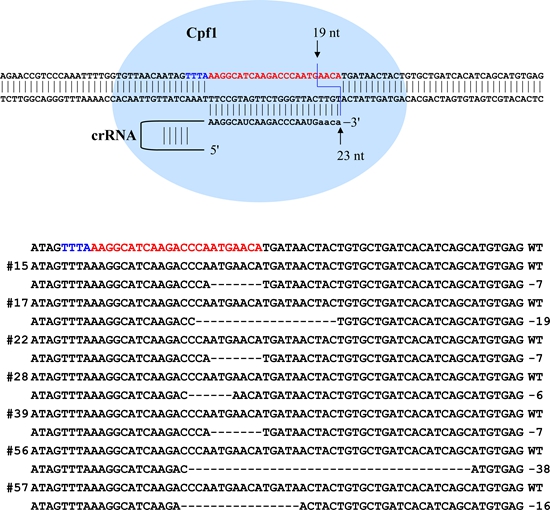分享到
Genome Editing in Rice Using CRISPR-Cpf1 System
Cpf1 is a class 2/typeV CRISPR effector that has been recently harnessed for genome editing in animal and human cell. Compared with CRIPSR-Cas9 system, Cpf1 recognizes thymidine-rich sequence as the protospacer-adjacent motif (PAM) at the 5’ end of target sequences (generally, 5’-TTTN). It requires only a single shorter crRNA (40 nt) and cleaves DNA in a staggered fashion with 5′ overhangs. However, the function of Cpf1 in plants still remains unexplored.
Recently, Wang’s research team from China National Rice Research Institute (CNRRI) carried out genetic transformation with codon-optimized Cpf1 of Lachnospiraceae bacterium ND2006 and Acidaminococcus sp. BV3L6 in rice. The results showed that CRISPR-LbCpf1 system can be used for genome editing in rice. Thus, the work provides an alternative genome-editing tool in plants.
This work was supported by the National Natural Science Foundation of China, the Zhejiang Provincial Natural Science Foundation of China, and the Agricultural Science and Technology Innovation Program of Chinese Academy of Agricultural Sciences. The research finding has been published in Journal of Genetics and Genomics online on December 5, 2016 (DOI: http://dx.doi.org/10.1016/j.jgg.2016.12.001). More details are available on the links bellow: http://www.sciencedirect.com/science/article/pii/S1673852716301916

By Wang Kejian
Recently, Wang’s research team from China National Rice Research Institute (CNRRI) carried out genetic transformation with codon-optimized Cpf1 of Lachnospiraceae bacterium ND2006 and Acidaminococcus sp. BV3L6 in rice. The results showed that CRISPR-LbCpf1 system can be used for genome editing in rice. Thus, the work provides an alternative genome-editing tool in plants.
This work was supported by the National Natural Science Foundation of China, the Zhejiang Provincial Natural Science Foundation of China, and the Agricultural Science and Technology Innovation Program of Chinese Academy of Agricultural Sciences. The research finding has been published in Journal of Genetics and Genomics online on December 5, 2016 (DOI: http://dx.doi.org/10.1016/j.jgg.2016.12.001). More details are available on the links bellow: http://www.sciencedirect.com/science/article/pii/S1673852716301916

By Wang Kejian
wangkejian@caas.cn
Latest News
-
 Apr 18, 2024Opening Ceremony of the Training Workshop on Wheat Head Scab Resistance Breeding and Pest Control in Africa Held in CAAS
Apr 18, 2024Opening Ceremony of the Training Workshop on Wheat Head Scab Resistance Breeding and Pest Control in Africa Held in CAAS -
 Apr 03, 2024IPPCAAS Co-organized the Training Workshop on Management and Application of Biopesticides in Nepal
Apr 03, 2024IPPCAAS Co-organized the Training Workshop on Management and Application of Biopesticides in Nepal -
 Mar 28, 2024Delegation from the School of Agriculture and Food Science of University College Dublin, Ireland Visit to IAS, CAAS
Mar 28, 2024Delegation from the School of Agriculture and Food Science of University College Dublin, Ireland Visit to IAS, CAAS -
 Mar 25, 2024Director of World Food Prize Foundation visited GSCAAS
Mar 25, 2024Director of World Food Prize Foundation visited GSCAAS -
 Mar 20, 2024Institute of Crop Sciences (ICS) and Syngenta Group Global Seeds Advance Collaborative Research in the Seed Industry
Mar 20, 2024Institute of Crop Sciences (ICS) and Syngenta Group Global Seeds Advance Collaborative Research in the Seed Industry
